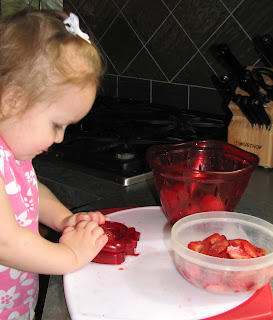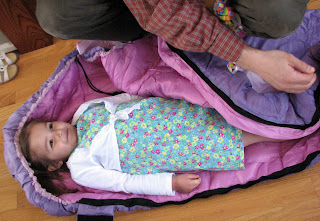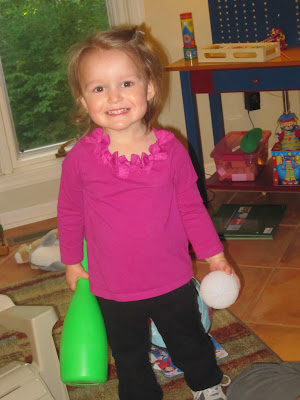When Humphrey discovered that the Toddler Room at our school did not do a Birthday Celebration like the Early Childhood classes, she decided to have one at home for Magoo. It kinda makes me laugh, she spent 2 years in the Toddler Class and only after experiencing her own Birthday Celebration did she realize that was her first one at school.
When I walked into the living room the other day Humphrey and Magoo were each in a chair along with 2 naked baby dolls talking about Magoo's life.
I mentioned that I have a copy of On the Day You Were Born and Humphrey immediately requested we read it to Magoo.
A little while later Magoo helped make her birthday cupcakes, she loved pouring the ingredients and mixing them together.
The big day finally arrived and we began the day with balloons and cinnamon rolls for breakfast. Our first of many renditions of Happy Birthday occurred at this time.
After a morning at school, a long nap, and Papa's softball game in the evening we made it to unwrapping the present. She unwraps just like her older sister...all bits of paper off the box before opening the box.
She got a tiny wiffle ball bat (lightweight) a regular mitt & ball so she can play with Humphrey, and a bike helmet.
Overall a successful day.
Friday, May 20, 2011
Wednesday, May 18, 2011
Remembering
When touring potential families at our school I find it difficult to be concise in my delivery, especially when they have not researched "Montessori Education" and the philosophy behind it. When individuals or couples come and have specific questions I am relieved and am able to address their particular needs as well as expand upon what they may know or are observing through the viewing windows. I can talk Montessori all day long...remembering to hit the key points in order for parents to sign on the dotted line without overwhelming them is the tricky part.
I am currently reading: Montessori in Practice--Observations from a First-Generation Montessorian, and am reminded of many key points that I am excited to share in staff development meetings, in the courses I teach in our teacher training program and with tours.
- Maria Montessori did not create a "method of education", she devised a way "to help the children help themselves".
- The Montessori approach is not a "cure", but rather a "prevention".
- Not specifically from this book, but the underlying principle is there. The main goals for the children educated in the Montessori approach between the ages of 0-6 are: to be independent, to have confidence, to be able to concentrate, to display coordination and have a sense of order about them. Academics are wonderful and a large part of the Montessori classroom, but not the direct goal. When the children are shown respect, are given the chance to be individuals and develop the five main goals, the acquisition of academics occurs naturally.
Monday, May 16, 2011
Language Activities That Enrich Children’s Exploration
As you have most likely noticed in your son or daughter, young children love words. The sensitive period for language development is strong throughout the birth to six year period. The natural ability for children to absorb the totality of language is observed in the child’s correct use of grammar, syntax and vocabulary. Children also have a tendency for exploration and the discovery of the unknown motivates them to strive for more information and knowledge. Children explore with their senses as well as with language. The interaction between sensorial exploration and language acquisition forms a strong foundation for intellectual growth.
The following activities require little preparation and are those that you can enjoy doing with your children.
Auditory Discrimination is very important for listening, following directions and preparation for reading.
· With eyes closed, the child listens and identifies various sounds in the environment, such as running water, feet crunching in the snow, egg beater, ringing bells, clapping, singing, knocking. Ask questions about the sounds, such as level of loudness or softness.
· Matching sounds of such things as rhythm instruments; identifying those that are the same, different, louder or softer.
· Identifying beginning sounds of words by playing I Spy with my eyes something that starts with the sound of ‘c’ and child points or names ‘cup’.
Listening / Direction Games helps children remember and process auditory directions or instructions. This skill is very essential for many academic lessons throughout the school years.
· Give the child a simple one or two step command such as open the cabinet and select a glass. Before child moves, ask, “What are you going to do?” When child finishes the task, ask, “What did you do? What did you do first? What did you do next?”
· Gradually add steps for practice with three or four steps as appropriate for the age of child.
· Tell a story by making a statement and asking questions to form the story. For example, “Grandma is baking a cake”; “why is she baking a cake?” Add the child’s answer to the story, “Grandma is baking a cake for my birthday.” Other questions are “when did she bake the cake?” “How did she bake the cake” “where did she bake the cake?” With each response add to the story to form a simple story.
· Describe a sequence of actions such as the process for brushing teeth, getting dressed, making a sandwich or similar actions that are familiar to the child. Ask the child a series of questions about the order or sequence of events, such as “What did you do first when you made the sandwich?” Continue asking the ‘next step’ in the process, helping the child describe the sequence of actions.
Reading and Telling Stories Interactive story telling even when ‘reading’ the book helps the child focus on details, gain expressive language that adds to the meaning of the story, and encourages a love of reading and a foundation for reading comprehension skills.
· Identify the title, author and illustrator for each book.
· Spend time looking at the pictures and noticing details of expression, action and other clues that reveal something about the content or characteristics of the characters.
· Read the story with expression which helps the child understand the meaning of the story, sequence of events, cause and effect, and the personality of the characters.
· As often as possible ‘tell’ the story even if you don’t remember all the words in the sentence. By telling, you can make eye contact with the child or watch expressions or reactions to the story.
· Talk about the story – point out relationships between the story and the pictures and discuss the story, particularly giving the child time to reflect and share ideas.
Naming, Matching and Grading The skill for identifying similarities, differences, gradations and matching is a basic pre-reading skill.
· Memory-picture type games can be modified for different ages and improves memory and recognition of like identities.
· Use pictures of peoples of all ages to discuss emotions and gain the language for self-expression and needs. Move beyond the basic sad and happy to such words as excited, concentrating, thoughtful, and contemplative. Children easily grasp the meanings for emotional language when words and pictures are combined.
· Comparing size, shape, colors such as grading crayons by shades, grading silverware by size or finding shapes in common items, such as rectangles in doorways, cylinders in cans are means to focus attention on details and build analytical skills.
· Sense explorations – Make food tasting an adventure with small samples which compare sweet, sour, salty, bitter tastes. Explore smells with teas, herbs, seasonings, fruits by using a blindfold and describing the smells. Tactile explorations also offer opportunities to refine vocabulary in the use of adjectives to describe the experiences.
· Music and art explorations can be combined by playing different types of music and providing a variety of art media for creative self-expression based on the tone and rhythm of the music.
· Music and movement explorations are great opportunities for word games and simple action stories. For example, “We are going on a bear hunt” with descriptions of actions and corresponding movements.
Any of these activities can be improvised and incorporated into many routines such as car travel, getting dressed, before meals and waiting in line. Although many similar activities are presented in videos and on television, the interactions between the adult and child have a stronger impact on the child’s developing brain. There is a personal and natural link between a child and an adult that stimulates the emotional and intellectual learning processes. Young children, especially, gain a deeper understanding of the meaning of words and stories when watching the face and mouth of the adult. Enjoy the discoveries of your son or daughter as you explore language. It is through language that cultures, societies and families are united across the ages; it is through language that humans have always expanded knowledge and it is through language that emotional and personal bonds are formed between peoples.
Saturday, May 14, 2011
Dirt is fun!
It seems that there is a lot of discussion about children and outdoor free play, getting children back into playing in the natural world and allowing them to simply get dirty. I remember playing in a sandbox for hours on end and sometimes even flooding it with a hose in order to make it a constructions zone for Tonka trucks. Have we made the world too sterile for our children, always ready with the hand sanitizer or wipes to keep them free of dirt or germs? This spring Magoo has enjoyed digging with a spade in our huge pot that we use for tomato plants. I knew that in order to prevent the plants from being dug up I needed to offer her an alternative for something dirty and messy to do outside. We live on a very wooded lot, but that does not mean I want the girls to be digging holes all over the place. After a discussion I had concerning Sensorial ideas for toddlers I happened to be in a store that had big tubs in with all of the summer stuff (Walmart).



Transferring Dirt
Materials Needed:
2 Tubs ($4 each at Walmart, in a variety of colors)
Dirt or Potting Soil
Scoop, Spoon or Ladel

Friday, May 13, 2011
Strawberries for Snack
This afternoon Humphrey and Magoo took part in preparing their own snack. I was washing off some strawberries and Humphrey brought her step stool over to see what I was doing; she then asked if she could remove the stems. While I busied myself with unloading and loading the dishwasher, Humphrey hulled the entire container of strawberries. After the last one, she leaned over to wash her hands and proclaimed herself done.
Minutes later, Magoo climbed up to see what was going on and asked if she could slice them. How could I argue, I had purchased this nifty little set from Amazon a couple of months ago and they like to use it every chance they get. So...Magoo busied herself with slicing all of the strawberries, one at a time in our nifty strawberry slicer and removing each one into a serving dish.

While it took most of an hour for the girls to prepare their late afternoon snack, they were able to prepare it themselves...perhaps they enjoyed this yummy spring treat a little more then when it is just sitting out waiting for them to come and eat--something to ponder.
Wednesday, May 11, 2011
Making a Masterpiece - Montessori Art
A couple weeks ago our school hosted a parent education night that incorporated a brief power point about the role of art in the Montessori early childhood classroom and then offered a time for parents to create or "Make a Masterpiece" alongside their child/ren. Turnout was decent, it seem like attendance is always less than we anticipate. Micheal Olaf graciously allows schools to share much of their printed information with parents and friends...
Art in Montessori does not mean coloring books or group projects imitating a model created by the adult. It is about true creativity, expression, joy, and it is connected with all other areas of study such as biology, history, music, math, and so on. The child's original work is the goal.
Thursday, May 5, 2011
Cinco de Mayo
Today was the big day...Humphrey had her first Montessori birthday celebration. She was thrilled to have mama & papa both there to witness her walk with the earth around the sun. After her walk around the sun four times; she made a wish, blew out the candle (sun), we listened to On The Day You Were Born, by Debra Fraiser and and the class sang "Happy Birthday" by Tom Chapin. She then gifted the class with the book Elmer, a book we picked out yesterday--we sat through that reading and class time was over.
Other fun things we did today...
- Blueberry muffins with candles at breakfast
- Birthday Balloons
- Papa came home for lunch--panini's were the lunch of choice for this birthday girl
- Super-yummy delicious Chocolate Cavity Maker Cake
- Nap time in a super-duper present -- sleeping bag
 |
| My 1st sleeping bag...I'm so excited! |

Subscribe to:
Posts (Atom)













